
Architect’s Primer
on Renewable Energy
SPRING 2021

This publication is designed to provide accurate and authoritative information in regard to
the subject matter covered. It is published and distributed with the understanding that the
publisher is not engaged in rendering professional services. If professional advice or other expert
assistance is required, the services of a competent professional person should be sought.
AIA does not sponsor or endorse any enterprise, whether public or private, operated for profit.
Further, no AIA officer, director, committee member, or employee, or any of its component
organizations in his or her official capacity, is permitted to approve, sponsor, endorse, or do
anything that may be deemed or construed to be an approval, sponsorship, or endorsement
of any material of construction or any method or manner of handling, using, distributing, or
dealing in any material or product.

/ 3AIAArchitect’s Primer on Renewable Energy
Contents
1. Introduction ....................................................................................................4
2. Before you begin .............................................................................................9
Design for energy conservation and efficiency first ..........................................9
Building performance simulation/energy modeling is a must ......................10
Have the renewable energy talk ............................................................................ 10
3. Renewable energy technologies ................................................................. 11
Solar photovoltaic technology ................................................................................ 11
Solar resources ........................................................................................ 12
Design considerations ............................................................................. 12
Roof considerations ................................................................................. 13
Solar-ready design ........................................................................................... 14
Other renewable energy technologies ................................................................. 14
Wind ..................................................................................................................... 14
Wind resources .......................................................................................... 14
Design considerations ............................................................................. 14
Hydroelectric ..................................................................................................... 15
Micro-hydro resources ............................................................................ 15
Design consideration ............................................................................... 15
Biomass .............................................................................................................. 16
Biomass resources ....................................................................................17
Design considerations ..............................................................................17
Energy efficiency technologies that use renewable resources ...................... 18
Solar thermal .................................................................................................... 18
Passive solar thermal systems ...................................................................... 18
Solar pool heating systems ............................................................................ 19
Active solar thermal systems ........................................................................20
Heat pumps ....................................................................................................... 21
4. Storage ...........................................................................................................22
5. Paying for renewable energy: on-site and off-site ................................ 24
On-site options ........................................................................................................ 26
Ownership ......................................................................................................... 26
Leasing .............................................................................................................. 26
On-site power purchase agreement (PPA) .............................................. 26
Off-site options ........................................................................................................27
6. Stretch your thinking ................................................................................. 28
7. Credits & resources ..................................................................................... 29

1. Introduction
/ 4AIAArchitect’s Primer on Renewable Energy
With the impacts of climate change increasing
dramatically, and the cost of renewable energy
technologies decreasing dramatically, now is the time
to incorporate a renewable energy solution for every
project you undertake. As an architect, clients and the
design team look to you for leadership, setting the tone
for design and the design process. You have the power
to offer renewable energy for serious consideration.
The good news is that incorporating renewable
energy into your projects is probably easier and more
affordable than you think. You don’t have to be an
expert. You simply need enough information to begin
the necessary conversations and investigations, and to
find the right expertise for the design team.
The basic steps for most projects:
1. Set energy use intensity (EUI) targets
2. Use design strategies to optimize energy
performance (e.g., massing and orientation, natural
ventilation, solar and shading, daylight, envelope/
façade) and select energy efficient technologies and
strategies (e.g., HVAC equipment and schedules,
internal loads reduction strategies and schedules).
3. Use building performance simulation (aka energy
modeling) to determine the anticipated energy
needs of the building from both conventional and
renewable sources.
4. Offset EUI from conventional sources with renewable
energy—on-site and/or off-site.
5. Design “solar ready” if solar is not installed as part of
the project already.
6. Discuss resilience and energy storage with your client.
A roof-mounted solar photovoltaic (solar PV) is the
simplest, most economical form of renewable energy
for most building types and climates. Small wind
systems, micro-hydro systems, and heat and electricity
from biomass are also options. Energy efficiency
technologies that use some form of renewable
energy (e.g., solar thermal systems and air-source,
ground-source, and water-source heat pumps) are
good options to pair with other renewable energy
technologies. Battery and thermal storage can help you
optimize the use of renewable electricity generation.
And if you can’t include renewable energy on a project,
procuring off-site renewable electricity and designing
“solar-ready” are musts.
Buildings as energy producers: This is the cutting
edge of design for architects today. The electric grid
is changing significantly. Nearly all electricity in
the U.S. used to be generated by coal-fired power
plants and large hydroelectric projects, and that
electricity was distributed to customers far and
wide with a lot of inefficient losses in the process.
More and more electricity is now being generated
by “distributed resources” such as rooftop solar PV,
rather than centralized power plants. The electric
grid is a massive network, and, historically, buildings
have been passive consumers on that network,
consuming 70% of the electricity generated in the
U.S. Increasingly, with distributed energy systems,
leading the charge, buildings are becoming active
participants in that network—as energy producers, not
just passive consumers. Already in some jurisdictions,
renewable energy is a requirement, not a choice, for
new construction. Requirements for “solar-ready”
new construction are becoming more common. With
climate change becoming a more urgent issue, it stands
to reason that these kinds of requirements will not
remain outliers. If you want to remain competitive and
distinguish yourself in a crowded field of architectural
firms, your projects must include solar PV (or other
on-site renewable electricity) as a critical part of their
design or, at the very least, be solar ready.

/ 5AIAArchitect’s Primer on Renewable Energy / Introduction
Solar PV—Rooftop Residential
Solar PV—Rooftop C&I
Solar PV—Community
Solar PV—Crystaline Utility Scale
Solar PV—Thin Film Utility Scale
Solar Thermal Tower with Storage
Geothermal
Wind
Gas Peaking
Nuclear
Coal
Gas Combined Cycle
ALTERNATIVE
ENERGY
CONVENTIONAL
$0 $25 $50 $75 $100 $125 $150 $175 $200 $225 $250
$151
$75
$64
$36 $44
$29
$32 $42
$148
$126
$69
$28
$150
$118
$66
$44 $68
$152
$192
$199
$54
$112
$156
$154
$242
LEVELIZED COST ($/MWH)
$33
$89
DG
DG
DG
Distributed generation
Arguments in favor of renewable energy used to
be about the environment and combating climate
change, but for many projects, the costs just didn’t
pencil out. Recently, costs have come way down,
while the environmental benefits remain.
The cost of renewable electricity is increasingly
competitive with conventional electricity.
The cost of renewable electricity generation has
decreased dramatically, even when financial
incentives are not considered. Utilities, a notoriously
conservative business sector, are building solar and
wind generation because it is cheaper than fossil
fuel and nuclear or hydro generation. As they add
more renewable capacity, it helps lower the price of
renewables for everyone else.
UNSUBSIDIZED LEVELIZED COST OF ENERGY COMPARISON
The financial case for renewable energy

/ 6AIAArchitect’s Primer on Renewable Energy / Introduction
Solar PV—the most likely choice for architects—
is seeing significant cost reductions.
Solar PV has recently become cost-competitive
with conventional electricity generation in many
states, especially those with favorable policies.
The “soft costs” of PV (e.g., design, permitting,
financing, installation, and labor) remain relatively
high compared to the hardware (PV modules,
mounting system) and balance of systems (BOS)
(inverter, wiring, switches, meters, batteries) costs.
Nevertheless, total first costs have decreased
significantly and will continue to do so as more
building-scale installations occur, enabling
expertise to grow and spread. Although design fees
are part of soft costs, it’s important to note that
reducing soft costs does not mean reducing fees.
It means reducing the designer’s learning curve to
increase profit.
RESIDENTIAL PV (6.2k W) COMMERCIAL PV (200k W)
$0
$1
$2
$3
$4
$5
$6
$7
$8
2010 2011 2012 2013 2014 2015 2016 2017 2018 2010 2011 2012 2013 2014 2015 2016 2017 2018
2018 USD PER WATT DC
2018 Costs for residential & commercial PV
$7.34
$6.44
$4.55
$3.97
$3.49
$3.23
$3.02
$2.84
$2.70
$5.43
$5.04
$3.47
$2.82
$2.80
$2.30
$2.20
$1.88
$1.83
2018 COSTS FOR RESIDENTIAL & COMMERCIAL PV

/ 7AIAArchitect’s Primer on Renewable Energy / Introduction
Solar ITC schedule
2020
26%
2021
22%
2022
Commercial
& utility-scale
Residential
10%
0%
Now is a good time to invest in solar
Tax credits and financial incentives reduce the initial
costs of solar PV systems. A federal investment tax
credit (ITC) for solar is beginning to scale down, but
it still reduces the cost of the system significantly.
There are also many utility, state, and local incentives
for energy efficiency and renewable energy projects.
The best source of information about these
incentives is the Database of State Incentives for
Renewables & Efficiency (DSIRE). You should also
check with your local utility and state energy office
for information about incentives. The National
Association of State Energy Offices (NASEO) has a
helpful membership directory of state energy offices.
Fuel for solar, wind and micro-hydroelectric
systems is free
Unlike fossil fuel systems, once these renewable
energy systems are up and running their operational
costs are very low. Renewable energy systems need
differing levels of maintenance, but except for biomass
systems, their fuel is free as long as the sun shines,
the wind blows, and the water flows. Depending on
the specifics of the project, biomass fuels can also be
much less expensive than fossil fuels.
SOLAR ITC SCHEDULE
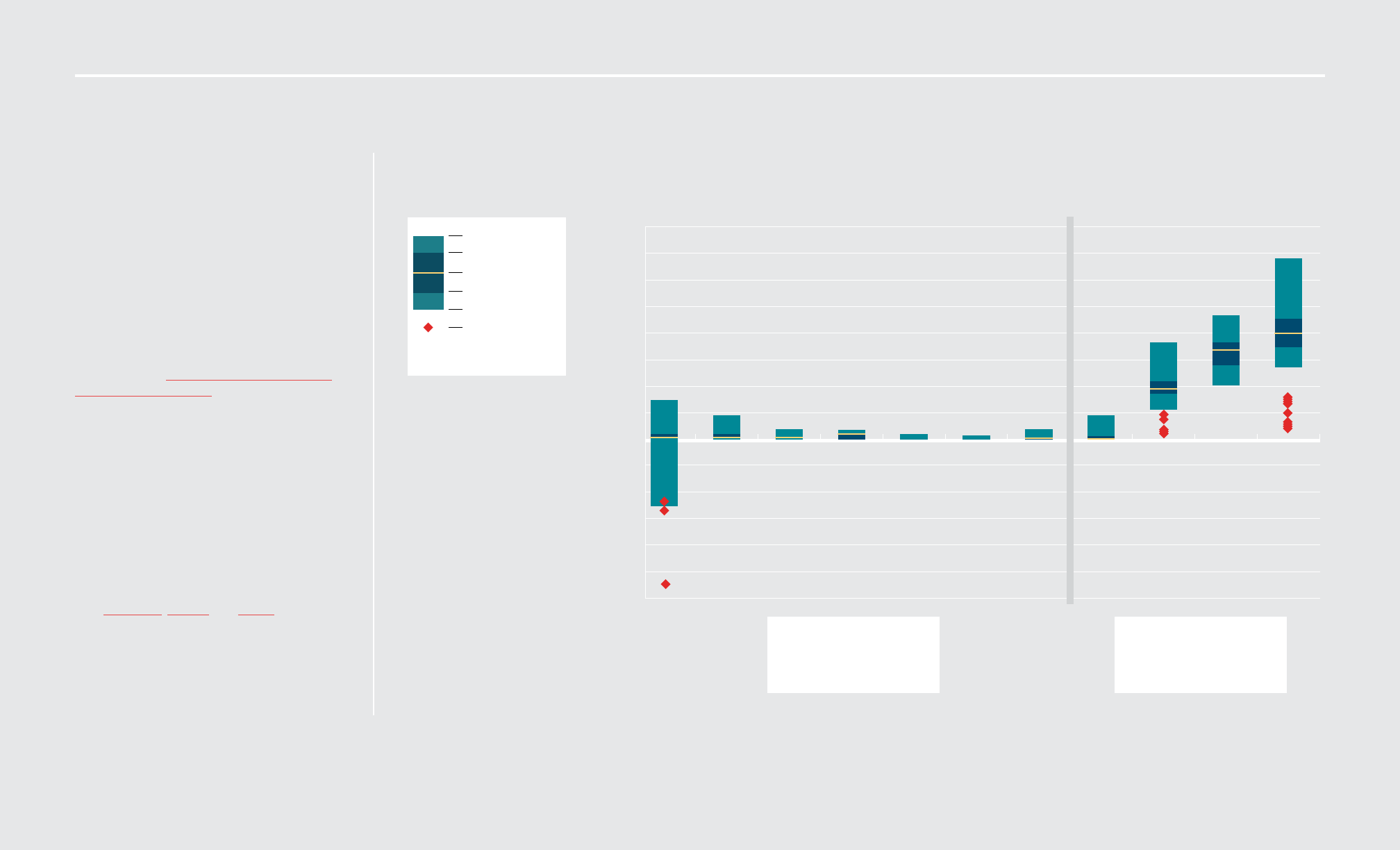
/ 8AIAArchitect’s Primer on Renewable Energy / Introduction
Transitioning to renewable electricity generation
is essential for environmental quality and to
reduce climate change.
The environmental benefits of renewable energy
have only become more important in recent years.
The AIA declared a climate emergency in July 2019
and adopted the AIA Resolution for Urgent and
Sustained Climate Action. To address the emergency,
we must decrease the carbon intensity of electricity.
Renewable electricity emits significantly less
greenhouse gases than fossil-fuel generation.
Renewable energy is the future
Any important investment must consider the future.
Both new and retrofitted buildings certainly qualify as
important investments. Currently, the median lifespan
of a commercial building is 70 to 75 years and should
be longer. Because that lifespan has a lot of ripple
effects for society at large, considering the future of
a building is especially important. Diverse sources
(e.g., Bloomberg, Deloitte, and Forbes) predict that
renewable electricity will be the energy of the future.
Benefits of renewable energy
generation
0
250
500
750
1,000
1,250
1,500
-1,500
-1,250
-1,000
-750
-500
-250
1,750
2,000
Photovoltaics
Concentrating solar power
Geothermal energy
Hydropower
Ocean energy
Wind energy
Nuclear energy
Natural gas
Oil
Coal
Biopower
Maximum
75th percentile
Median
25th percentile
Minimum
Single estimates
with carbon capture
and storage (CCS)
ELECTRICITY GENERATION
TECHNOLOGIES POWERED BY
RENEWABLE RESOURCES
ELECTRICITY GENERATION
TECHNOLOGIES POWERED BY
NON-RENEWABLE RESOURCES
LIFE CYCLE GREENHOUSE GAS EMISSIONS [G CO₂ EQUIVALENT/KWH
*
*
Avoided emissions, no removal of greenhouse gases from atomsphere
RENEWABLE ENERGY TECHNOLOGIES HAVE LESS GREENHOUSE GAS EMISSIONS

/ 9AIAArchitect’s Primer on Renewable Energy
2. Before you begin
There are a few things to consider before you dive right
into incorporating renewable energy into your next project.
If you aren’t familiar with the integrated design process,
you should be. Designing a building that effectively and
economically incorporates renewable energy requires
multiple points of view on the design team early on and
through multiple iterations of the project. LEED 4.0
offers information about (and one point for) using an
integrative process. You will also want to optimize energy
performance by designing for energy conservation and
efficiency first, and making rigorous use of building
performance simulation (energy modeling).
Design for energy conservation and
efficiency first
Including renewable energy in a project does not replace
the need for good energy design practices. Designing for
energy conservation and efficiency is essential to reducing
the first costs of any renewable energy system; the less
energy the building uses, the smaller the renewable energy
system needs to be. Energy conservation and efficiency
also add other benefits, including reducing building first
costs through load reduction and operational utility costs.
The Architecture 2030 Palette offers specific design
strategies (scroll down for site- and building-specific
strategies). The AIAU AIA + 2030 series also explores
many of these strategies.
Low EUI targets are crucial to buildings that
incorporate renewable energy systems. Achieving these
low EUIs, or getting all the way to net zero energy
(buildings that produce as much energy as they use
over the course of a year), can be challenging on many
levels. Some architects perceive high-performance
low-energy design and aesthetic design decisions as
an “either/or.” In other words, they might perceive
achieving a low EUI as an unwanted challenge to their
creativity as a designer. However, it can just as easily
be said that if the architect isn’t designing a building
that is high-performance, low-energy, and beautiful,
how creative are they actually being? Designing
beautiful buildings with low EUIs that incorporate
renewable energy is the creative challenge for the
architectural profession in the 21st century. AIA’s
Framework for Design Excellence (formerly COTE Top
Ten) clearly supports this idea, in particular with its
Designing for Energy component.
ENERGY CONSERVATION
ENERGY EFFICIENCY
RENEWABLE ENERGY
$
$$$
Building performance simulation
Solar & shading
Envelope/facade Natural ventilation
Massing & orientation
Daylight
Internal loads reduction
Internal loads schedules
HVAC equipment & schedules
On-site,
e.g., solar PV & wind
Off-site green
power purchases
CONSERVATION, EFFICIENCY, & RENEWABLE ENERGY

AIA / 10Architect’s Primer on Renewable Energy / Before you begin
Building performance simulation/energy
modeling is a must
To design a building best suited for a renewable
energy system, and to reach critical EUI targets,
building performance simulation is essential. AIA’s
Architect’s Guide to Building Performance can help you
integrate building performance simulation into the
design process and make better design decisions.
Have the renewable energy talk
Clients and design team members already look to
architects for discussions about budget, square
footage, program, materials, and more. Clients
will also look to architects to lead discussions
about strong EUI goals and renewable energy. The
architect must provide the leadership to establish an
energy budget that includes renewable energy and
communicate that budget to the client and the design
team. Similarly, the architect must be the one to lead
discussions about, and make the case for, zero energy
design. To do that, architects need to know more.
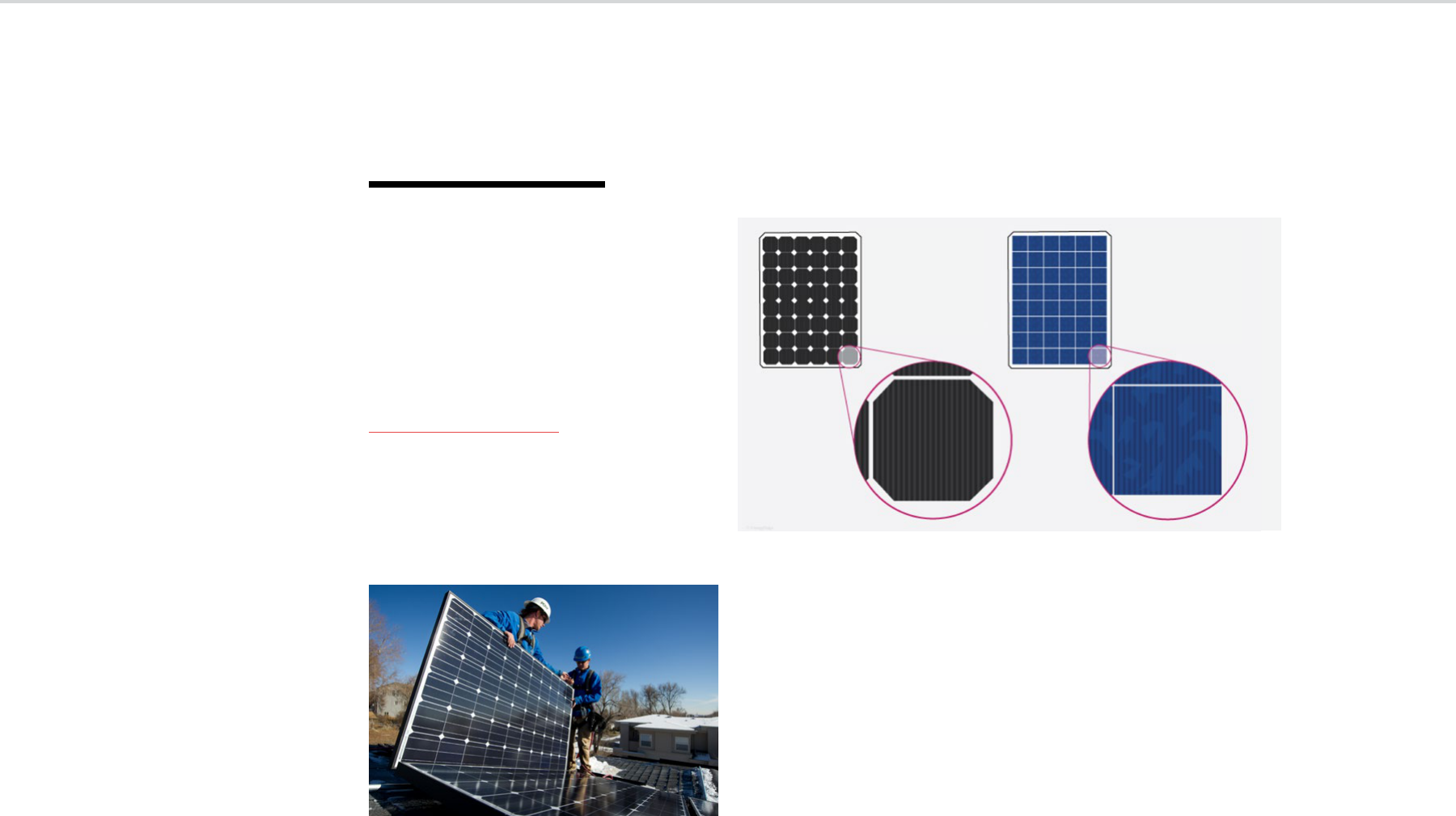
/ 11AIAArchitect’s Primer on Renewable Energy
3. Renewable energy technologies
Having an open, curious, and creative mind is the
best approach to selecting the right renewable energy
system or systems for any project. Solar PV is usually
the obvious choice for most projects. Nevertheless,
there are other technologies that can work well for some
projects, depending on location and available resources.
For this reason, information about small-wind, micro-
hydroelectric, biomass, and solar thermal systems is
included in this brief.
The AIA+2030 online series includes a course entitled
The Role of Renewable Energy.
Solar Photovoltaic Technology
In recent years, PV prices have steadily decreased,
making it cost-competitive with electricity generated
from fossil fuel in many markets. If you haven’t looked
at incorporating PV into your projects lately, look again.
Illustration of mono- and polycrystalline solar PV cells.
Rigid solar PV panels being installed on a roof.
Mono
To make cells for
monocrystalline
panels, silicon is
formed into bars and
cut into wafers.
Poly
To make cells for
polycrystalline panels,
fragments of silicon
are melted together to
form the wafers.
There are two basic types of PV:
1. Rigid panels (either monocrystalline or polycrystalline)
» 90% of the PV market
» More efficient electricity production—
monocrystalline 2224%; polycrystalline 1618%
» Most common on rooftops
» Additional options:
- awnings, carports, shade structures, courtyard
and walkway coverings
- replacing façade to envelope materials
2. Flexible thin films
» Less efficient electricity production (610%)
» Require more square footage compared to rigid
panels because they do not provide as much
electricity output per square foot
» Commonly used on glazing or in roofing materials
» “Peel and stick” PV also an option
» Typically, less available and less widely used;
ensure there is local expertise for design,
installation and maintenance

AIA / 12Architect’s Primer on Renewable Energy / Renewable energy technologies
Building Integrated PV (BIPV)
» PV (rigid or thin film) is integrated into the
building envelope.
» BIPV replaces a building component or
material (e.g., roofing, curtain wall, glazing,
exterior cladding).
Solar resources
Contrary to a common myth, solar PV makes as
much sense in the sunny Southwest as it does in the
Northeast. Policies and incentives have a much greater
impact than solar resource. That said, it is important to
understand that solar PV is an intermittent source of
electricity, usually generating the most electricity
10 am– 2 pm, with more generation in summer than
winter. But that doesn’t mean it doesn’t generate anything
during the winter, because the sun still provides light;
plus, cooler temperatures often make PV operate more
efficiently. The National Renewable Energy Laboratory
(NREL) online PVWatts Calculator is a great place to
start exploring available solar resources at a specific site.
Design considerations
Design decisions—orientation and tilt of the PV system
and available area without shade—have a much greater
influence on the performance of solar PV than does
building location. Like any building system, designing
and installing a solar PV solution that integrates
successfully with overall building design requires specific
expertise, and that expertise needs to be on the design
team from the very beginning. If you don’t have expertise
in-house, a solar consultant or installer can help.
Orientation
» Building design must feature an open roof area
or façade with long east-west axis for maximum
southern exposure.
» South-facing PV generates the most electricity.
» Southeast, southwest, and west orientations can
work too—don’t stress over perfect orientation.
» Solar PV system designers and installers use
software to predict annual performance of
different PV system solutions.
Tilt
» PV systems should be tilted toward the sun at an
angle equal to the latitude of the location.
» A 15- to 40-degree pitch can work; don’t stress
over perfect tilt.
» Tilt has less of an impact than orientation.
» Rack-mounted PV on flat roofs require a suitable
tilt, but design must ensure one panel doesn’t
shade another to an extent that it compromises
the optimal operation of the system.
There are multiple options for integrating solar PV into building design or mounting solar PV on a structure or site.
Roof-mounted PV options:
A flush-mounted rooftop solar PV system.
A rooftop solar PV system with ballasted footing mounts.
A tilted-rack mounted rooftop solar PV system.
Solar PV flush-mounted to a carport/shading structure.
Skylighted entryway featuring solar PV laminated to glazing
provides electricity as well as shade and daylight.

AIA / 13Architect’s Primer on Renewable Energy / Renewable energy technologies
Shade
» PV panels must be located so that they are
not shaded.
» Even a partially shaded PV panel or portion of a
PV panel provides reduced electricity production.
» As a rule of thumb, no panel should be shaded
more than 10% during peak hours of operation.
» Other buildings and structures, building
equipment, trees and landscaping, and other
PV panels can cause shade.
» Consider both present and future shade potential.
» Keep landscaping and trees trimmed to
prevent shading.
» Research possibilities for neighboring new
construction; not all jurisdictions have solar
access and easement laws to protect each
building’s right to the sun.
Site layout
» Careful site planning ensures the greatest amount
of area possible for the PV.
» The area (or areas) with the greatest solar
resource and the least shading are best for solar
PV placement.
» Whatever surrounds it must not cast a shadow
over the PV.
Roof considerations
» Roofing type will likely determine how the PV
system is mounted.
» Most roofing types work: metal standing seam,
Spanish and clay tile, EPDM, TPO, and PVC.
» Slate and wood shingles are not good roofing
materials for PV installation.
» Area available for PV is maximized by:
- minimizing roof penetrations,
- minimizing area dedicated to rooftop equipment,
- grouping penetration and equipment together,
and locating them on the north side.
» Walking aisles and perimeter provide access for
façade and roof maintenance; roof penetrations
can be grouped near aisles.
» Safety equipment for solar installation and future
access to the PV system are required.
» A PV system can add 3 to 6 pounds per square
foot; work with an engineer to ensure the roof is
capable of carrying the load.
» Wind loads should be analyzed to ensure the roof
structure can support the PV system.
A number of resources are available to further investigate
solar PV technology and the feasibility of a PV system:
» AIAU offers a course on Solar PV and the Architect.
» energysage offers a Solar 101 series and much more.
SUN’S PATH IN THE SKY
South
West
East
North
Photovoltaic
modules
June 21
December 21
INTEGRATING SOLAR PV INTO DESIGN

AIA / 14Architect’s Primer on Renewable Energy / Renewable energy technologies
Solar-Ready Design
Consumer preferences, state and local policies, and costs
are all pushing us toward a renewable energy future.
You want to be ready, and you want your clients to be
ready. Even if you can’t find a way to include solar PV on
a building project today, any new or renovated building
project should be optimized for solar PV in the future.
NREL’s “Solar Ready Buildings Planning Guide” offers
detailed information, and its State, Local, & Tribal
Governments program blog offers the highlights. Solar-
ready building features include:
» Design building massing and orientation to
optimize solar PV performance. Usually this means
a long east-west axis to maximize south-facing
roof area, but west- and/or east-facing PV may
also make sense.
» Be mindful of current and future shading.
» Minimize and group roof obstructions.
» Design extra roof load capacity, and specify
roofing materials that will last the life of the
solar PV system.
» Pre-install conduit from roof to equipment room.
» Set aside space in the equipment room for balance
of systems (e.g., inverter, breaker, meter).
» Ensure buildings systems can accommodate PV
interconnect/disconnect infrastructure.
» Set aside space and ensure infrastructure for
future battery storage.
Other renewable energy technologies
Whereas solar PV is the most common renewable
energy technology specified, it isn’t the only option. Small
wind and micro-hydroelectric are potential options for
building sites with adequate resource and available space.
Biomass for heating or electricity generation (or both) can
be either a building-level or building-site technology.
Wind
Architects are most likely to consider small wind systems
(up to 100kW). Larger wind systems are generally
considered utility-scale. Small wind systems consist of
blades, a rotor, generator or alternator, and usually a tail,
all of which are mounted on a tower. The rotating axis of
the turbine can be either horizontal or vertical.
Wind resources
Wind systems need adequate wind resource to produce
enough electricity to make the investment cost-effective.
The WINDExchange website has abundant information
about wind resource. These maps are a good place
to start, but more in-depth site-specific analysis is
required. A local dealer or wind-turbine manufacturer
can usually estimate the annual production of a specific
turbine size at a specific height, given the microclimate
of the site. It can assess the best system to match the
demand of the building to determine whether the wind
system alone is sufficient, needs to be paired with
another solution, or isn’t a good option at all.
Design considerations
Generally speaking, wind is not a building-level
technology. Turbines are usually installed on a tower
on the building site rather than on a building because
vibration from normal operation of the turbine travels
down the tower and into the building. Towers enable
turbines to both reach higher wind speeds and reach
above the wind turbulence that can be present closer to
the ground. Relatively small investments in increased
tower height can result in very high rates of return in
electricity generation. If a building-mounted system
is desired, the building must be engineered to support
the loads of the tower and turbine (e.g., weight and
vibration), and provide adequate access to the wind
resource and clearance for the equipment.
Small wind systems require adequate space for
equipment and equipment clearance:
» The U.S. Department of Energy (DOE)
recommends building sites of at least 1 acre,
but specific site conditions are the ultimate
determinant.
» Towers range from about 100 to 300 feet in
height; they require:
- clearance from surrounding buildings,
structures, and trees;
- enough clearance to accommodate the blades of
the turbine (e.g., 15-foot turbine blades require a
minimum clearance of 30 feet); local ordinances
and/or insurance companies may require clearance
that equals 1.25 to 1.5 times the height of the tower.
A typical horizontal-axis small wind turbine with blades, rotor,
generator/alternator and tail atop a tower.
Solar-ready architecture featuring a long east-west axis with
adequate south-facing roof for solar PV
Small vertical-axis wind turbines

AIA / 15Architect’s Primer on Renewable Energy / Renewable energy technologies
Whereas a manufacturer can provide analysis, it
will likely refer you to a local dealer that can act as
a consultant on the design team, install the system,
and provide aftermarket maintenance. Ongoing
maintenance by a qualified technician is critically
important for a small wind system.
Some projects may want a small-wind system
specifically because they are highly visible renewable
energy systems. Schools, for example, may like
the visibility of wind for educational purposes. A
business or municipality may choose wind because
it’s good marketing and outreach to customers and
the community—a farm supply company or municipal
building in Iowa, for example, where farmers often
lease their land to wind farm developers.
To further investigate small wind technology and the
feasibility of a wind system, DOE has published an
extensive Small Wind Guidebook (available online
and as a PDF).
Hydroelectric
Hydroelectric power is most often a utility-scale
technology associated with large dams. Those dams
have significant environmental impact, so even
though they produce low-carbon electricity that offers
steady baseload power, in comparison to intermittent
variable technologies like solar and wind, large-scale
hydroelectric power is not ideal.
However, run-of-water micro-hydroelectric (“micro-
hydro” for short) systems, if implemented correctly,
cause less environmental impact. These small systems
(thus “micro”) can be suitable for building sites that have
access to naturally flowing water via a stream or river with
suitable vertical drop. They use the natural downward flow
of rivers and streams and micro turbine generators to
generate electricity. Typically, water is taken from a river
or stream at a high point (the diversion) and gravity-fed
down a pipe (the penstock) to a lower point where it
emerges through a turbine generator and re-enters the
regular water flow. Installation of such a system can be
INVERTER
METER
Load
AC
TAIL
ROTOR
TOWER
GENERATOR/
ALTERNATOR
relatively cheap, has less environmental impact than
larger hydroelectric power options, and still provides
baseload (vs. variable) power.
Micro-hydro resources
To determine the feasibility of a micro-hydro system,
a site assessment is critical. This includes accurate
measurements of head and flow.
» Head: measure of total vertical drop of water—the
difference in elevation of the source of water and
the turbine; typically measured in feet
» Flow: volumetric measure of moving water;
should be measured throughout the year; typically
measured in gallons per minute
Design considerations
Micro-hydro systems are not a building-level
technology, but they can have significant site impacts.
When designing the system there are important
environmental and aesthetic considerations.
» Design and locate intake diversion and screen
(where the water leaves regular flow and enters
the penstock) for easy maintenance access and
minimal impact to wildlife.
» Correctly size penstock, typically PVC or HDPE pipe,
and install with minimal damage to the environment.
» House turbine and generator, and install run of wire
(carries electricity to building load) to maximize
aesthetics and minimize environmental impacts.
Diversion
Stream
Penstock
Pelton wheel
turbine
Electrical
generator
Tall
race
SMALLWIND GRIDTIED SYSTEM
RUNOFWATER MICROHYDRO SYSTEM

AIA / 16Architect’s Primer on Renewable Energy / Renewable energy technologies
Micro-hydro systems have specific permitting
requirements that may involve more than local codes
and ordinances. Depending on local utility policies,
tying the system to the grid may be more complex than
solar PV or small wind. Because the system typically
impacts naturally flowing water, entities concerned
with water resource rights and quality—including the
U.S. Army Corps of Engineers and state/local natural
resources and fish and game departments—may also
have requirements. The importance of researching
these permitting requirements before committing to
such a system cannot be overstated.
The DOE has additional resources (Microhydropower
Systems and Planning a Microhydropower System) as
does Alternative Energy News (Micro Hydro Power—
Pros and Cons). Appalachian State University provides
a Fact Sheet: Microhydro that is intended for North
Carolina but also contains helpful general information.
Biomass
Biomass is the use of organic material (i.e., from
plants and animals) for energy production. Examples
of biomass energy sources include wood, forestry
and agricultural waste, specific crops, and landfill
waste and gas. Biomass consists of three main types:
biofuels for transportation; bioenergy for heat and
electricity generation; and bioproducts for plant-based
plastics and other materials. Bioenergy for heat and
electricity are the technologies architects will most
likely be concerned with. There are three ways to
generate bioenergy:
1. Burning
» Provide heat directly for space heating (e.g., woody
biomass fueled boiler for hydronic heat).
» Create steam to drive turbines to generate electricity,
including in “co-generation” with fossil fuels.
» Generate syngas through gasification (similar
to combustion, but with limited oxygen input) to
generate electricity and waste heat for combined
heat and power.
2. Bacterial decay
» Collect biomass material in oxygen-free “digesters”
where it decomposes, producing methane. Burn
the methane to provide heat or generate electricity.
3. Conversion to gas/liquid fuel
» Fuels can act as substitutes for or complements to
natural gas for heating and/or power generation.
Biomass can stimulate complex discussions about
just how low carbon the technology actually is. There
are also concerns about whether growing feedstock
(plants) for biomass requires land to be cleared that
otherwise wouldn’t have been or uses land that is
better-suited to grow food.
The environmental and climate impacts are not as
clear-cut as they are for other renewable energy
technologies. On the other hand, human society
produces waste, and it may be better than not to
burn, decay, or convert that waste. Consider waste
byproducts from paper and lumber mills, crops, food,
and municipalities, which are all potential sources
of biomass. Methane from agricultural manure and
human sewage are also abundant and will produce
methane whether it gets used as a biofuel or not. In
some areas of the U.S., historical forestry practices
have resulted in conditions that contribute to wildland
A pellet- fueled boiler system in the Ketchikan, Alaska, airport. Current generation
bioenergy equipment benefits from decades of R&D and is currently cleaner, more
efficient, and smaller than its predecessors.
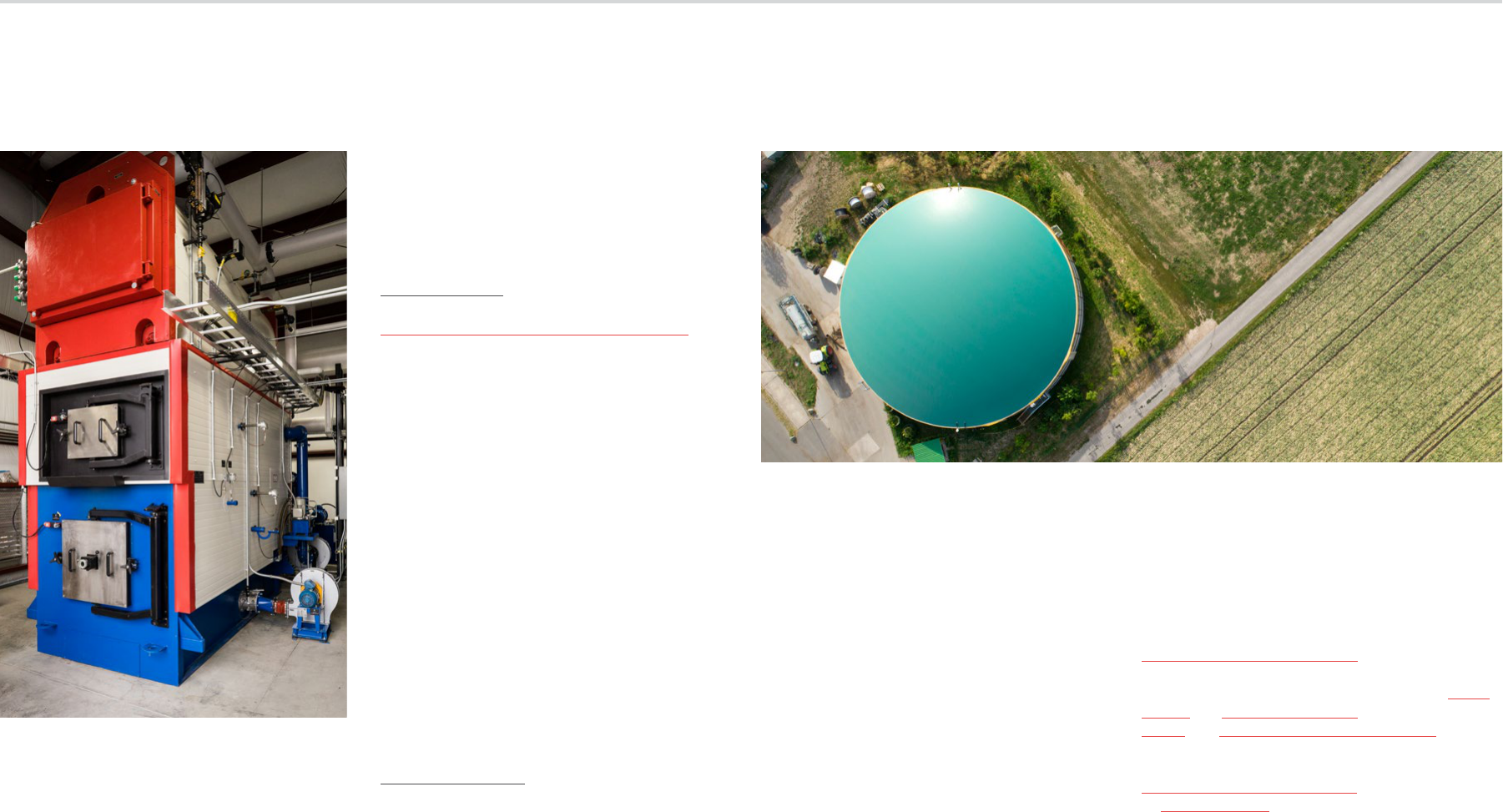
AIA / 17Architect’s Primer on Renewable Energy / Renewable energy technologies
fires and limit forest diversity. Considering any of
these sources of waste, using biomass resources to
generate bioenergy for heat and electricity makes sense
generally, and, depending on location and access to
biomass resources, may make good sense for your
project specifically.
Biomass resources
The National Renewable Energy Laboratory provides
multiple geospatial maps of biomass resources
that can be great places to begin when it comes to
understanding the availability of and proximity to
biomass resources for any project. However, like any
project considering renewable energy, it is critical to
consult an expert early on to get a better understanding
of resource and feasibility issues.
Because of the extra sensitivity around the true
sustainability of biomass resources, it’s crucial to
understand how the project influences and interacts
with local supply of biomass. Questions to consider: Will
using the biomass resource help make an area forest
healthier or make good use of local biomass waste?
Will it support the local economy (e.g., forest-related or
agricultural businesses)? Can green waste be diverted
from landfills to supply the resource? Are there waste
streams for biodigester processes that can be used?
When the biomass resource is understood, it is critical
to scale systems appropriately. You don’t want to
create more demand for biomass resource than there is
adequate supply.
Design considerations
Generally speaking, bioenergy is a more effective
commercial or industrial solution (with the exception
of modern woody biomass boilers for residential
applications). Schools, municipal buildings, year-round
swimming pools, businesses that require process heat,
electricity-intensive industries, district heating—these
are all examples of projects for which bioenergy can
make sense. With district systems there also may be
opportunities for co-generation and combined heat
and power. Because bioenergy systems are diverse,
it’s important to research design considerations for a
specific system. That said, some very general design
considerations include:
» All systems require space (e.g., a combustor and
boiler for woody biomass systems).
» Electricity generation systems also require space
for a turbine, generator, and cooling tower.
» Storage or collection for biomass fuel.
» Means of delivering the fuel (e.g., a conveyer to
the combustor in the case of woody biomass or a
manure management system for a digester).
» Most components are integrated into one unit for
smaller space heating systems using woody biomass;
larger systems are usually configured specifically.
» Space heating systems may also require
conventional backup.
The Whole Building Design Guide by the National
Institute of Building Sciences (NIBS) provides more in-
depth information about bioenergy systems for space
heating and electricity generation as well as producing
biogas. The Biomass Energy Resource Center (BERC)
has general information about biomass and works
to support community-scale biomass energy. The
Biomass Thermal Energy Council (BETC), in particular
its Resource Center, has information about biomass for
heat and combined heat and power.
A community/very small bioenergy-fueled district system (4–6
block radius) in Burns, Oregon. The system provides hot water heat
to the county circuit court, sheriff’s office, and jail as well as an
elementary school and a mental health center. The new one-boiler
system replaced three oil boilers. Because modern equipment is
more efficient, it uses less resource to achieve desired heat and/or
power output and has less impact on air quality.
Biogas plant

AIA / 18Architect’s Primer on Renewable Energy / Renewable energy technologies
Energy efficiency technologies that use
renewable resources
In addition to true renewable energy technologies
that generate electricity or provide heat, there are
important energy efficiency technologies that use
renewable resources or complement renewable energy
systems, or both.
Solar thermal
Unlike solar PV, which converts sunlight to electricity,
solar thermal systems capture the sun’s heat in a
collector containing a fluid such as air, water, or
propylene glycol. Solar thermal systems can be used
for pool heating, water heating, space heating, or
preheating for high-temperature water or steam.
Because most of these projects require additional
or backup heating systems to operate, they are
not strictly considered renewable energy systems,
but rather energy efficiency measures that use
renewable energy. In recent years, it’s often cheaper
to use solar PV to power heat pump systems rather
than investing in solar thermal for space and water
heating on a smaller scale (e.g., residential, small
commercial). Solar pool heating and domestic water
heating in no-freeze climates are the exceptions;
these systems can often pay back relatively quickly.
Solar thermal systems are definitely worth considering
for any project that has high-volume and/or high-
temperature hot-water demand. The cost of such
demand may very well make the system cost-effective
and worth any extra effort for maintenance. Examples
include dormitories, camps, recreational centers,
hotels, laundries, and industrial processes.
Solar thermal systems can be active or passive systems
that use flat-plate, evacuated tube, or unglazed
collectors. Active systems, which are more common in
freeze climates, use circulators and other mechanical
parts to function. Passive systems, which are more
common in non-freeze climates and for pool heating,
require no circulators.
Passive Solar Thermal Systems
» Passive systems have integrated storage or
no storage.
» Hot water rises naturally from the collector to
the storage tank.
» Roof must be able to support the weight of
the system.
» In no-freeze climates, they may be as cost-
effective as solar PV.
» Systems operate with less risk and maintenance.
» Systems don’t require backup.
Outer case of tank
T&P valve
Insulation
Pressurized
innter tank
Hot water
output
Cold water intake
Frame
Reflector
Tube ring
Heat pipe and
aluminium circle
Evacuated tube
Leg pad
End bracket
PASSIVE SOLARTHERMAL SYSTEM WITH AN EVACUATED
TUBE COLLECTOR AND INTEGRATED STORAGE

AIA / 19Architect’s Primer on Renewable Energy / Renewable energy technologies
Solar Pool Heating Systems
» Passive systems with unglazed collectors (typically).
» Pool is the storage system.
» Water is heated directly in the loops of the
collector and circulated to the pool via the pump.
» Using nighttime cooling, can be “reversed” to lower
pool-water temperature.
» Freeze or no-freeze climates—solar pool heating
works as long as the system is drained before
a freeze.
» Little to no maintenance required.
Sensor
Solar
collectors
Flow
control
valve
Check valve
Filter
Strainer
Conventional pool heater
Pump
SOLAR POOLHEATING SYSTEM

AIA / 20Architect’s Primer on Renewable Energy / Renewable energy technologies
Hot water
to house
Cold water
supply
Solar storage/
backup water heater
Antifreeze fluid in
collector loop only
Flat-plate
collector
Double-walled
heat exchanger
Pump
Active Solar Thermal Systems
» Collectors have freeze-proof fluid in the loops of
the collector.
» Circulator moves fluid to a heat exchanger in a
storage tank in a conditioned space.
» Tank includes backup heating.
» In climates with any risk of freeze, active systems
are required.
» Active systems are more complex than passive
(more potential points of failure) and require at
least annual maintenance.
ACTIVE SOLAR THERMAL SYSTEM
WITH A FLATPLATE COLLECTOR
This recreation center features an active solar thermal system using evacuated tube collectors (foreground) that provides heat for a
large public swimming pool. The solar PV on the roof provides electricity.
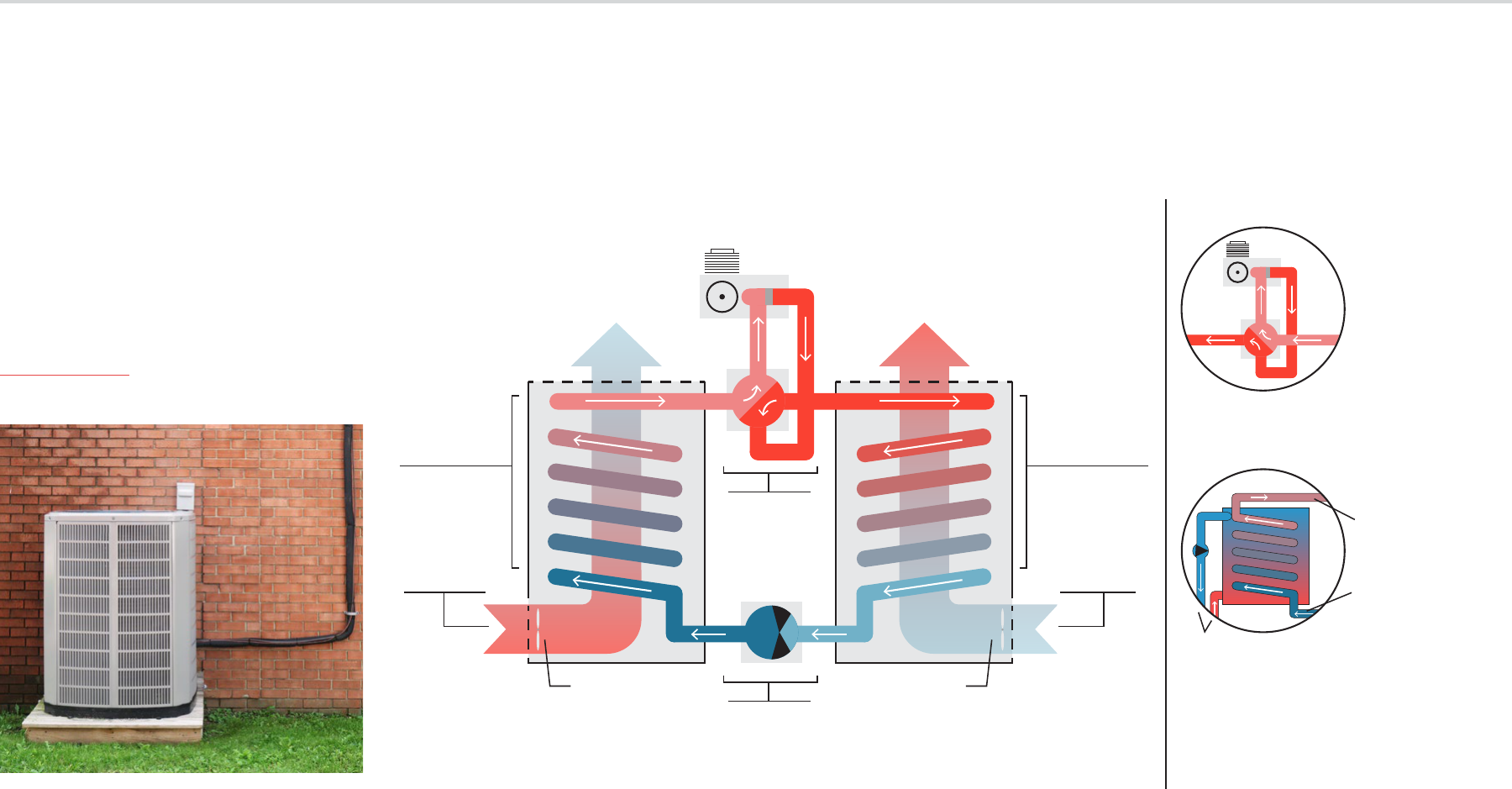
AIA / 21Architect’s Primer on Renewable Energy / Renewable energy technologies
Reversing valve:
Changes refridgerant
direction for heating or
cooling cycles.
Exterior heat
exchanger:
Cold liquid
refridgerant is warmed
by outside air and
evaporates as its
temperature increases.
Air from outside:
Warmer than
liquid refrigerant.
Fan:
Draws outside
air through
heat exhange.
Cold air
to outside
Hot air
to inside
AN AIR-SOURCE HEAT PUMP IN HEATING MODE
HEAT PUMP COOLING MODE
Air from inside:
Cooler than gas
refrigerant.
Expansion valve:
As the pressure of the liquid
refridgerant drops, the
temperature drops further.
“Interior” heat
exchanger:
Hot gasified refrigerant
releases heat to the
inside air and condenses
to a liquid as it cools.
The reversing valve allows the whole system to run in
reverse, extracting heat from the home’s interior and
releasing it to the outside.
Fan:
Draws interior
air through
heat exchanger.
GROUND-SOURCE HEAT PUMPS
Use a heat-transfer fluid and liquit-to-liquid heat exhanger
to extract heat energy from the earth or a water source.
SPLIT SYSTEMS
The “interior” heat exchanger can be located outside, using ducting
to move hot air to the inside space, or it can be located inside in a
separate “split” unit that uses refrigerant to move heat between the
two heat exchangers.
HEATING WATER WITH HEAT PUMPS
Like the liquid-to-liquid heat exchanger on the exterior side of a
ground-source heat pump system, an interior heat exhanger can
heat water for domestic use.
To compressor
From
expansion
valve
To/from
Heat pumps
Heat pumps provide space heating and cooling and
hot-water heating. They work by moving heat from
the air, ground, or water and don’t actually generate
hot or cold air. As a result, they are much more energy
efficient than conventional HVAC and water heating
systems. These systems, with air-source being the
most common, are becoming the “go-to” space
heating/cooling and water heating technology for all-
electric buildings that use solar PV or other renewable
electricity. The DOE offers basic information about
heat pump systems.
HOW A HEAT PUMP WORKS

/ 22AIAArchitect’s Primer on Renewable Energy
4. Storage
Storage related to buildings with renewable energy
systems can be thermal or electric. Batteries provide
electricity storage. Thermal storage uses electricity
to nearly freeze a water and ethylene or propylene
glycol mix in a storage container; then fans and
heat exchangers are used to deliver cooled air to
conditioned space. Similarly, electricity can be used to
heat a fluid to deliver heat to a conditioned space.
Thermal storage strategies are already proven and
cost-effective when used to take advantage of lower
electricity rates. They can be even more effective when
coupled with renewable energy systems because it
allows for more flexibility. The value of the electricity
generated on-site becomes an additional factor in
optimizing the rates paid for electricity.
The cost-effectiveness of battery storage is less
certain at this time. However, battery costs are
coming down and the technology is improving, so it is
likely batteries will become increasingly cost-effective
into the future. Lithium ion batteries are the most
likely choice for building-level battery storage. As the
technology used in hybrid-electric and all-electric
vehicles, it has a track record and a known lifespan of
10 years or more.
There are several reasons to consider storage. If the
grid goes down, a renewable energy system plus
battery storage supports resiliency through continuity
of operations. Many buildings have backup generators
that require fuel and regular maintenance precisely
for this purpose. For renewable energy systems plus
batteries, especially if they’re financed together, you
pay once but get a much more flexible (you can use it
every day, not just for emergencies) and cost-effective
solution that doesn’t require additional fuel purchases
and maintenance. For solar PV plus batteries, it is
also possible, as long as the project meets certain
requirements, to include the battery costs in the overall
system costs to reap the benefits of financial incentives.
Renewable energy systems with either battery
or thermal storage allow building owners to take
advantage of time-of-use rates that don’t usually
coincide with times of peak generation from renewable
energy systems. They can also help avoid demand
charges. Renewable energy plus storage systems can
also support low-carbon grid operations by reducing
or eliminating typical afternoon peak electricity
demand for electricity generated using fossil fuels.
Deciding on whether to choose storage at all, or
which type of storage is right, depends on the value
of continuity of operations, rate incentives, or carbon
(or all three) compared to the cost of the storage
solution. Just like EUI targets and renewable energy
system options, storage is an essential discussion
point for any project, and it has to be considered
early in design. Given future projections about the
increasing use and decreasing costs of batteries, even
if battery storage doesn’t make sense for the present,
the design should absolutely plan for battery storage
in the future.
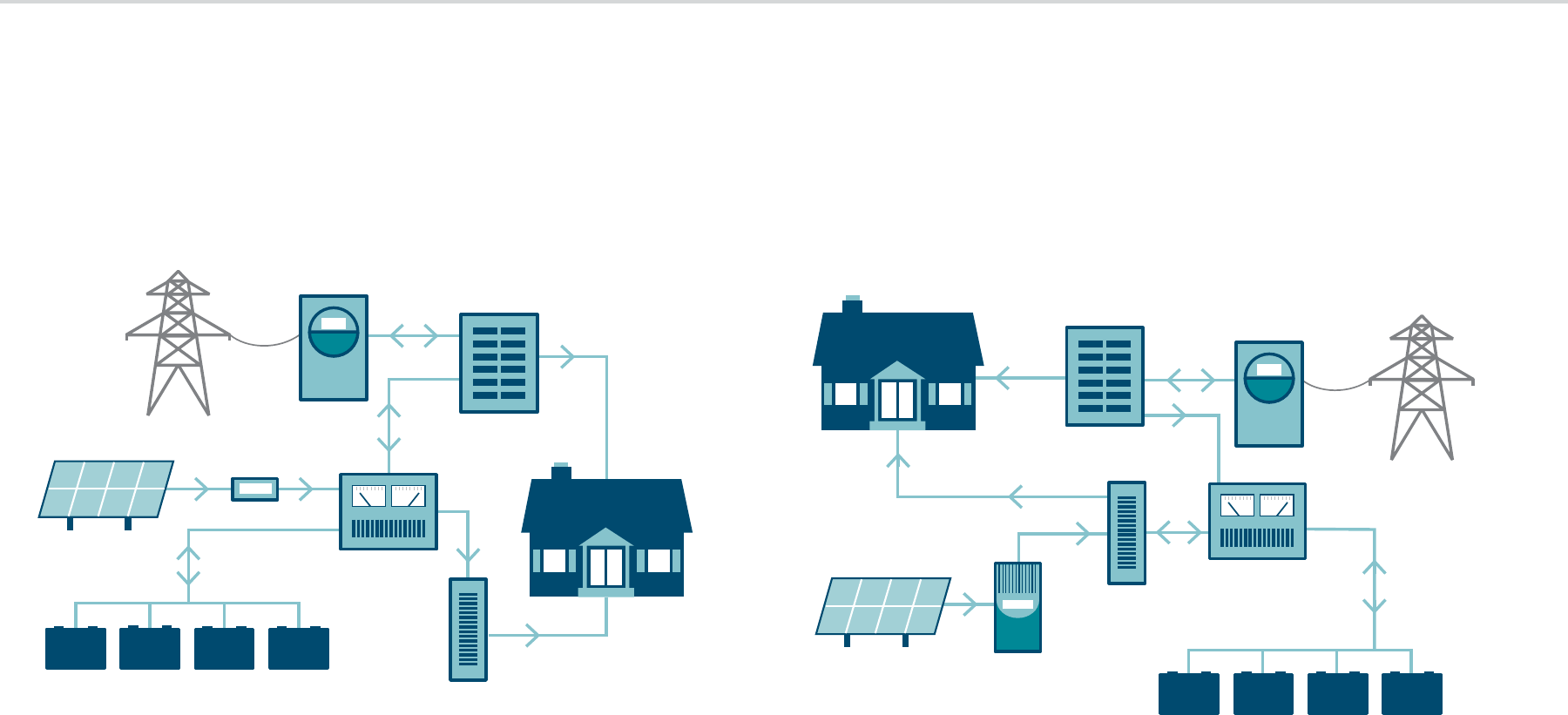
AIA / 23Architect’s Primer on Renewable Energy / Storage
Utility meter
Main circuit
breaker panel
Battery-based
inverter
Critical load
subpanel
Charge controller
Solar array
Energy storage
Utility meter
Main circuit
breaker panel
Battery-based
inverter
Critical load
subpanel
Grid-tied
inverter
Solar array
Energy storage
SOLAR + STORAGE SYSTEM OPTIONS
DC-coupled solar + storage systems allow batteries to charge directly from the solar PV. They tend to be
the most cost-effective for new installations and operate with better battery-charging efficiencies.
AC-coupled solar + storage systems are usually recommended for existing solar PV installations.

AIAArchitect’s Primer on Renewable Energy / 24
5. Paying for renewable
energy: on-site and off-site
For the architect, client, and design team, a key
decision point fundamentally influences the way in
which renewable energy systems are paid for. Will the
system or systems be on-site, located on the building
or building site, or off-site? Or will the project use
a combination of on-site and off-site? With on-site
systems, the building owner has the option to own the
renewable energy system and reap the benefits of tax
credits, depreciation, and available incentives. With
ownership, of course, also comes the responsibility
of operations and maintenance. With an off-site
system, the owner is not likely to own the system, and
therefore does not reap the aforementioned financial
benefits. The different options for handling renewable
energy credits (RECs) associated with either on-site
or off-site generation may also be an influencing
factor (see sidebar).
Renewable energy certificates (RECs)
There are a lot of different generation assets (e.g., fossil fuel,
renewables, hydro, nuclear) on the grid. It is impossible to say
whether the electricity you consume is coming from renewable
sources. The REC system (aka renewable energy certificates or
credits, or green tags) is basically an accounting and verification
system that enables tracking and trading of the clean energy
attributes of renewable electricity.
» Electricity generated from renewable energy is assigned a value
in RECs (1 MWh = 1 REC).
» Each REC has a unique serial number to prevent
double counting.
» RECs can be:
- associated with local or distant generation, and with
generation from new or existing renewable energy projects,
- traded and purchased,
- “bundled”—traded/sold with the renewable electricity, or
- “unbundled”—traded/sold separately from the electricity.
You are consuming renewable electricity if you:
» own or lease an on-site renewable electricity system or
enter into a power purchase agreement (PPA) and do retain
ownership of the associated RECs,
» purchase green power with bundled RECs, or
» purchase bundled RECs from a local electricity provider.
You are not consuming renewable electricity if you:
» own or lease an on-site renewable electricity system or enter
into a PPA and do not retain ownership of the associated RECs,
AIA

/ 25AIAArchitect’s Primer on Renewable Energy / Paying for renewable energy: on-site and off-site
FOSSIL-FUEL GENERATION
RENEWABLE ENERGY GENERATION
GRID
CONSUMER
Owned
Leased
Green power programs
Community solar
Load
PPA
Unbundled
NOT providing benefits of
renewable electricity to grid
Providing renewable benefits
to grid but NOT consuming
renewable electricity
Providing renewable benefits
to grid AND using renewable
electricity
Bundled
REC
REC
CONSUMER PURCHASES REC FROM RENEWABLE
ENERGY SOURCE AND CONTRIBUTES BENEFITS
OF RENEWABLE ENERGY TO THE GRID
Mixed electricity sources
HOW RENEWABLE ENERGY CERTIFICATES WORK » purchase green power with unbundled RECs,
or
» purchase unbundled RECs.
However you should choose to acquire RECs, you
should ensure that they are third-party–certified
and –verified (e.g., Green-e).
If the RECs associated with your electricity
decisions are not bundled, you can still contribute
renewable energy benefits to the grid, even if
you aren’t technically using renewable electricity.
Examples include:
» A building owner with an on-site solar PV
system that is leased or procured via a PPA
without retaining ownership of the RECs
contributes the benefits of the system but isn’t
consuming renewable electricity because the
lessor or PPA provider owns the RECs.
» A building owner who owns an on-site solar
PV system but sells the RECs associated with
the electricity generation is not consuming
renewable electricity but is still contributing
benefits to the grid.
» A building owner who has no on-site
renewable generation but purchases bundled
RECs is consuming renewable electricity while
also supporting new or existing renewable
electricity generation projects.

AIA / 26Architect’s Primer on Renewable Energy / Paying for renewable energy: on-site and off-site
On-site options
Ownership
Renewable energy systems can be purchased
outright with capital on-hand, or they can be
financed. Renewable energy system providers/
installers, especially for solar PV and wind, often
offer information about financing, if not access to
actual loans.
Options for residential systems:
» Finance the system only via a loan.
» Finance the system and additional construction or
renovation via a loan.
» Fannie Mae offers the HomeStyle® Energy mortgage.
» FHA Energy Efficient Mortgages are offered
through a variety of lenders.
Options for non-residential systems (including
multifamily):
» Financing options are much more diverse.
» The DOE’s Better Buildings Financing Navigator
is an excellent source of information.
A significant plus of ownership is the ability to reap the
benefits of tax credits for the cost of the system as well
as depreciation. Tax credits exist at the federal level and
in some states as well. Additionally, states, counties,
cities, and utilities offer financial incentives and loan
programs for renewable energy systems. The best
sources for information about financial incentives are:
» Database of State Incentives for Renewables &
Efficiency® (DSIRE)
» State energy offices; contact information can be
found in the membership directory of the National
Association of State Energy Officials (NASEO)
» Local utilities
» Local dealers and installers of renewable
energy systems
» Federal and state agencies (e.g., Department of
Agriculture, National Forest Service, Department
of the Interior, state natural resources agencies,
university/county extension services) may have
specific programs, for example, for agriculture,
related to biomass
Leasing
Solar PV systems are relatively easy to lease. At least
one company offers small wind leases, provided your
site consists of at least 3 acres of land. Micro-hydro
and bioenergy systems are typically not leased.
Solar PV leasing:
» Upfront costs are reduced or eliminated.
» Lessee provides benefits of renewable electricity to
the grid.
» Lessor maintains the system.
» Lessor receives all tax benefits, incentives, and RECs.
» Lease periods are typically 710 years or more.
» Leases often have buyout options after about
7 years.
» Lessee typically pays a flat monthly payment for
the equipment.
» Payments may escalate over time; ensure terms of
the lease are fully understood.
» Monthly payment is based on estimated electricity
production throughout the year; if production is
higher than estimated, lessee will likely receive a
“true up” bill for the value of the extra generation.
» Lease has to be transferred to the new owner, if a
building is sold.
» Leasing is generally recommended for owners who:
- cannot afford upfront costs,
- cannot reap tax benefits,
- do not expect to sell the building for the life of
the lease, or
- are comfortable not retaining the RECs
associated with generation.
On-site power purchase agreement (PPA)
» PPA provider/installer installs, owns, and
maintains the system.
» PPA provider/installer reaps any tax and incentive
benefits; usually keeps the associated RECs.
» Consumer usually enters into PPA for about 20
years; if this commitment poses a challenge,
leasing may be a better option.
» Similar benefits to leased systems, with one
significant exception: PPAs are not viewed as a
debt, whereas leases are.
» Consumer either pays a set kWh rate for the
energy actually produced by the system each
month or a flat monthly fee.

AIA / 27Architect’s Primer on Renewable Energy / Paying for renewable energy: on-site and off-site
» Flat-fee customers usually have a true-up period
every 1 to 3 years.
» Buyout options after about 7 years are common.
» $$$
Off-site options
There are many options for procuring off-site renewable
electricity. Here are some examples:
» Green pricing. Within noncompetitive electricity
markets (the utility owns generation, transmission,
and distribution), the local utility will likely have
a voluntary green pricing program. The customer
enters a short-term agreement (e.g., monthly)
to pay a premium/fee beyond the usual utility
rate to “buy” some or all of their electricity from a
renewable power source. RECs may be bundled or
unbundled. These programs are typically offered to
residential and small-commercial customers.
» Competitive electricity markets. Within
competitive electricity markets (utility owns
transmission and distribution but not all the
generation), the consumer can choose from
electricity providers. Typically, these markets have
more renewable electricity purchasing options.
RECs may be bundled or unbundled.
» Community solar. A solar PV project that
generates renewable electricity that is shared by
more than one property with subscribers usually
located in the same community or utility service
area. The project can be owned by the community
that shares the electricity, the utility, or a third
party that provides the renewable electricity to the
community. The project uses the local utility for
transmission and distribution. Subscribers purchase
a percentage of their annual electricity usage
from the project. Existing utility billing remains in
place; subscribers typically receive a credit on their
bill for the amount of electricity generated by the
community project. The Solar Energy Industries
Association (SEIA) has a “Residential Consumer
Guide to Community Solar.”
» Community choice aggregations (CCAs). Local
governments aggregate customer demand within
a specified jurisdiction and procure power while
continuing to use the local utility’s transmission
and distribution services. CCAs allow the
community greater choice in electricity generation.
» Utility green tariffs. Similar to green pricing, but
agreements are longer term (e.g., 1020 years).
The customer may have some say in the type of
renewable generation, and electricity costs may be
competitive (e.g., no fee above the utility’s usual
rate and the possibility of locking in a fixed rate
for term of the agreement). These programs are
typically offered to a class of large commercial
customers.
» Utility bilateral agreements. One-to-one contract
between a large commercial customer and a utility
to procure renewable electricity of a specific type
for an agreed-upon time period and rate.
» Power purchase agreements (PPAs). Like the
on-site PPA option, but generation is off-site.
There are two types of off-site PPAs: physical and
financial (also called virtual or synthetic PPAs).
EPA’s Green Power Partnership offers information
about physical and financial PPAs.
» REC purchases. Consumers can purchase
unbundled RECs from various organizations to
offset the electricity they use that is generated
from fossil fuel sources. It is important that these
RECs are third-party–certified and –verified. It
should be noted that whereas RECs can be used
to offset electricity consumption, there is some
discussion about using them to offset on-site gas
usage. For example, the EPA and eGreen do not
recommend it, but the ZERO Code does allow it.
» Renewable energy investment funds (REIFs).
These accounts are set up to receive funds from
building owners or developers when sufficient on-
site renewable generation is not possible. The fund
is typically managed by a local government with
a role for the local utility likely as well. The fund
is used to develop new renewable generation or
to purchase a virtual PPA. ZERO Code has more
information about REIFs.
The details of how a consumer purchases renewable
electricity can vary from state to state, utility territory
to utility territory, and by customer type. Architecture
2030 published the “ZERO Code Off-Site Procurement
of Renewable Energy,” and the EPA’s Green Power
Partnership website contains a wealth of information to
assist with navigating these differences.

/ 28AIAArchitect’s Primer on Renewable Energy
6. Stretch your thinking
Now that you’ve begun to learn more about renewable
energy options for your projects, here is some
information about the way renewable energy is starting
to change the electric grid.
As more and more intermittent and variable renewable
energy technologies are used to generate electricity,
patterns of peak electricity generation are changing,
but patterns of peak demand (mostly from buildings)
are not. This creates a mismatch between the times
when the utility is most able to generate electricity
from renewable sources and the times buildings are
demanding the most electricity. Generation from solar
PV during very late summer afternoons is a good
example. Electricity demand to power residential air
conditioning ramps up and overlaps with existing
demand from commercial buildings. Because this
coincides with the sun getting lower in the sky,
generation from solar PV is waning. Generation from
wind can present a different problem. Electricity
providers may have too much electricity at night when
building demand is low. Meeting historical demand
patterns in a high-renewable-generation scenario
means the utility will likely bring more fossil fuel
generation, especially natural-gas-fired peaking plants,
online. However, if buildings can change their demand
patterns to better match the times of peak generation
from renewables, those fossil-fuel-generation assets
may not be necessary.
The concept of building design and operation that
actively takes grid conditions into account goes by a
few names: grid-interactive efficient buildings,
grid-integrated energy-efficient buildings, grid-optimal
buildings, grid-friendly buildings, and grid citizenship,
to name a few. Regardless of the name, there are
consistent themes:
» Design for passive, energy conservation and
energy efficiency first.
» Include appropriate renewable electricity
generation (e.g., on a solar-PV-saturated grid,
west-facing PV in addition to south-facing
PV could give the grid a little help during peak
demand).
» Include storage (thermal or battery).
» Design and plan for grid-responsive operations
(e.g., load shifting and demand response).
For further exploration of this topic:
» U.S. Department of Energy Grid-Interactive
Efficient Buildings, including its informative
“Buildings and the Grid” blog series
» Rocky Mountain Institute Grid-integrated Energy
Efficient Buildings
» Building Green Changing Building Design for a
Changing Electrical Grid (may require subscription
to view the full article)

/ 29AIAArchitect’s Primer on Renewable Energy
7. Credits & resources
Acknowledgements
Author
Ruby T. Nahan
Nahan Communications, LLC
Contributors
Sachin Anand
Principal, db/HMS
Kjell Anderson, AIA
Director of Sustainable Design,
LMN Architects
Peter Arsenault
Principal, Peter J. Arsenault, Architect
Jason Coughlin
Senior Project Leader, National
Renewable Energy Laboratory
Charles Eley
New Buildings Institute
Otto Van Geet
Principal Engineer, National Renewable
Energy Laboratory
Bruce Haglund
Distinguished Professor, University
of Idaho
Meagan Hartman
Project Development Manager,
Wisewood Energy
Vincent Martinez
Chief Operating Officer, 2030, Inc./
Architecture 2030
Kim Shinn
Principal/Sr. Sustainability Consultant,
TLC Engineering Solutions
Michael Soriano
Director, Sales and Marketing, Bergey
Wind Power
Steven Strong
President, Solar Design Associates
Paul Torcellini
Principal Engineer, National Renewable
Energy Laboratory
Paul Westbrook
President, RE:source Design
AIA Staff
Melissa Morancy, Assoc. AIA
Director, Sustainable Knowledge &
Engagement
Melissa Wackerle
Sr. Director, Sustainable Practice &
Knowledge
April Ovens
Specialist, Sustainability, Resilience,
& Disaster Assistance
Erin Egan
Account Manager
Stacy Moses
Art Director
Photo credits
Page 5: Lazard’s Levelized Cost of Energy Analysis - Version 13.0
Page 6: Original graphic from the National Renewable Energy
Laboratory’s U.S. Solar Photovoltaic System Cost Benchmark: Q1 2018
Page 7: Original graphic from the Solar Energy Industries Association
Page 8: Original graphic from the union of concerned scientists
Page 11: (Left) Photo by Dennis Schroeder, NREL 20030; (right)
EnergySage, a website to comparison-shop solar energy and battery
systems, as well as community solar.
Page 12: (Roof-mounted PV options from top to bottom, left to right)
Dennis Schroeder, NREL 45144, Dennis Schroeder, NREL 45230,
Dennis Schroeder, NREL 45189, Dennis Schroeder, NREL 45167;
(right) Lawrence Berkeley National Lab, NREL 01052
Page 13: Original graphics from Architectural Integration of Solar PV
into Building Design
Page 14: (Left) Lord Aeck Sargent/Tzu Chen; (top right) Bergey
Windpower, NREL 43632; (bottom right) Mike vanBavel/Dynamax Inc.
NREL 42795
Page 15: (Left) original graphic from DOE’s Small-wind Guidebook ;
(right) original graphic from Aurora Power
Page 16: Courtesy of Wisewood Energy, a biomass project development
firm based in Portland Oregon
Page 17: (Left) courtesy of Wisewood Energy, a biomass project
development firm based in Portland Oregon
Page 18: (Right) courtesy of Sunbank solar thesunbank.com
Page 19: (Right) original graphic from DOE Energy Savers
Page 20:(Left) Dennis Schroeder, NREL 45137
Page 23: Original graphic from 2015 Solar + Storage 101 publication by
the Clean Energy Group

AIA / 30Architect’s Primer on Renewable Energy / Credits & resources
Resources
If you’d like to dive deeper into the topics covered
in this brief, here are some additional resources for
you to explore. Please note that these resources are
provided for general information and may contain
reference to outdated information (e.g., energy codes,
financial incentives and certifications such as Energy
Star and LEED).
Energy conservation and efficiency
» AIAU+2030 Online Series
» Architecture 2030 ZERO Code and 2030 Palette
» ASHRAE Advanced Energy Design Guides
» Better Buildings Toolkits
Energy modeling
» AIA Architect’s Guide to Building Performance:
Integrating simulation into the design process
Solar PV
» AIAU course: Solar PV and the Architect
» Solar Energy Industries Association Residential
Consumer Guide to Solar Power
» Better Buildings Toolkits
» energysage: Solar 101: how does solar energy work?
» SunPower has a lengthy information-packed blog to
search, keeping in mind the blog also features plenty
of promotion of their own products
Wind
» DOE: Small Wind Guidebook
Micro-hydroelectric
» DOE: Microhydropower Systems and Planning a
Microhydropower System
» Alternative Energy News: Micro Hydro Power—Pros
and Cons
» Appalachian State University: Fact Sheet: Microhydro
(intended for North Carolina but contains general
information)
Bioenergy
» National Institute of Building Sciences Whole Building
Design Guide: space heating and electricity generation
» Biomass Energy Resource Center
» Biomass Thermal Energy Council — Resource Center:
Strategic Communications
Solar thermal
» Environmental Protection Agency: Solar Heating and
Cooling Technologies
» National Renewable Energy Laboratory: Solar Energy
Basics (includes information about other solar
technologies too) and Climate Neutral Research
Campuses
Heat pumps
» DOE Energy Savers: Heat Pump Systems
Storage
» Clean Energy Group: Solar+Storage 101 (battery
storage)
» CALMAC: How Thermal Energy Storage Works
» Green Building Alliance: Thermal Storage
» BuildingGreen: Buildings on Ice: Making the Case for
Thermal Energy Storage (may require subscription to
view the full article)
Financing
» Fannie Mae HomeStyle® Energy mortgage
(residential)
» FHA Energy Efficient Mortgages (residential)
» DOE Better Buildings Financing Navigator (non-
residential, including multifamily)
» Database of State Incentives for Renewables &
Efficiency® (DSIRE)
» National Association of State Energy Officials
(NASEO): State and territory energy offices
membership directory
» Your local utility
» Local dealers and installers of renewable energy
systems
» energysage: Solar Financing
Green power
» ZERO Code Off-site Procurement of
Renewable Energy
» EPA Green Power Partnership website
» energysage: Green Power, RECs
Community solar
» Residential Guide to Community Solar
» National Renewable Energy Laboratory list of
community solar projects
» energysage: Community Solar
Changing electric grid
» DOE Grid-Interactive Efficient Buildings, including its
informative “Buildings and the Grid 101” blog series
» Rocky Mountain Institute Grid-Integrated Energy-
Efficient Buildings
» BuildingGreen Changing Building Design for a
Changing Electrical Grid (may require subscription to
view the full article)
